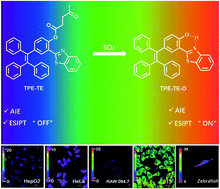当前位置:
X-MOL 学术
›
J. Mater. Chem. B
›
论文详情
Our official English website, www.x-mol.net, welcomes your
feedback! (Note: you will need to create a separate account there.)
An AIE + ESIPT ratiometric fluorescent probe for monitoring sulfur dioxide with distinct ratiometric fluorescence signals in mammalian cells, mouse embryonic fibroblast and zebrafish†
Journal of Materials Chemistry B ( IF 6.1 ) Pub Date : 2018-03-01 00:00:00 , DOI: 10.1039/c8tb00075a Yong Liu 1, 2, 3, 4, 5 , Jing Nie 6, 7, 8, 9 , Jie Niu 1, 2, 3, 4, 5 , Weishan Wang 1, 2, 3, 4, 5 , Weiying Lin 1, 2, 3, 4, 5
Journal of Materials Chemistry B ( IF 6.1 ) Pub Date : 2018-03-01 00:00:00 , DOI: 10.1039/c8tb00075a Yong Liu 1, 2, 3, 4, 5 , Jing Nie 6, 7, 8, 9 , Jie Niu 1, 2, 3, 4, 5 , Weishan Wang 1, 2, 3, 4, 5 , Weiying Lin 1, 2, 3, 4, 5
Affiliation

|
Sulfur dioxide (SO2) is associated with serious diseases including lung cancer, cardiovascular diseases, and many neurological disorders. However, discrimination of the physiological and pathological functions of SO2 in different living systems is restricted by the lack of functional molecular tools. To address this critical challenge, herein, we have developed a novel ratiometric probe, TPE-TE, for monitoring SO2 with distinct ratiometric fluorescence signals in mammalian cells, mouse embryonic fibroblasts, and zebrafish via a combination of an ESIPT mechanism and the aggregate fluorescence method for the first time. The TPE-TE exhibits well-resolved emission peaks, high sensitivity, excellent selectivity, and low cytotoxicity. Moreover, this probe possesses higher sensitivity in an aqueous solution than the current probes. Taking advantage of these prominent features, we have achieved the detection of endogenous and exogenous SO2 with distinct ratiometric fluorescence signals in mammalian cells and mouse embryonic fibroblast. For the detection of endogenous SO2, probe-loaded HeLa cells exhibited stronger ratiometric fluorescence signals than HepG2 cells. For the detection of exogenous SO2, it was found that macrophage cells exhibited stronger ratiometric fluorescence signals than cancer cells for the first time. Interestingly, mouse embryonic fibroblasts incubated with this probe showed unique ratiometric imaging. Moreover, TPE-TE could be suitable for ratiometric SO2 imaging in living zebrafish.
中文翻译:

AIE + ESIPT比例荧光探针可监测哺乳动物细胞,小鼠胚胎成纤维细胞和斑马鱼中具有不同比例荧光信号的二氧化硫†
二氧化硫(SO 2)与包括肺癌,心血管疾病和许多神经系统疾病在内的严重疾病有关。但是,由于缺乏功能分子工具,对不同生命系统中SO 2的生理和病理功能的区分受到限制。为了解决这一关键挑战,本文中,我们开发了一种新型的比例探针TPE-TE,通过结合ESIPT机制和聚集荧光,可监测哺乳动物细胞,小鼠胚胎成纤维细胞和斑马鱼中具有不同比例荧光信号的SO 2。方法的第一次。该TPE-TE具有良好的发射峰解析度,高灵敏度,出色的选择性和低细胞毒性。而且,该探针在水溶液中比现有探针具有更高的灵敏度。利用这些突出的特征,我们已经在哺乳动物细胞和小鼠胚胎成纤维细胞中实现了具有独特比例荧光信号的内源性SO 2和外源性SO 2的检测。为了检测内源性SO 2,与HepG2细胞相比,加载探针的HeLa细胞显示出更强的比例荧光信号。用于检测外源SO 2,发现巨噬细胞首次显示出比癌细胞更强的比例荧光信号。有趣的是,用这种探针孵育的小鼠胚胎成纤维细胞显示出独特的比例成像。此外,TPE-TE可能适合在活斑马鱼中进行比例式SO 2成像。
更新日期:2018-03-01
中文翻译:

AIE + ESIPT比例荧光探针可监测哺乳动物细胞,小鼠胚胎成纤维细胞和斑马鱼中具有不同比例荧光信号的二氧化硫†
二氧化硫(SO 2)与包括肺癌,心血管疾病和许多神经系统疾病在内的严重疾病有关。但是,由于缺乏功能分子工具,对不同生命系统中SO 2的生理和病理功能的区分受到限制。为了解决这一关键挑战,本文中,我们开发了一种新型的比例探针TPE-TE,通过结合ESIPT机制和聚集荧光,可监测哺乳动物细胞,小鼠胚胎成纤维细胞和斑马鱼中具有不同比例荧光信号的SO 2。方法的第一次。该TPE-TE具有良好的发射峰解析度,高灵敏度,出色的选择性和低细胞毒性。而且,该探针在水溶液中比现有探针具有更高的灵敏度。利用这些突出的特征,我们已经在哺乳动物细胞和小鼠胚胎成纤维细胞中实现了具有独特比例荧光信号的内源性SO 2和外源性SO 2的检测。为了检测内源性SO 2,与HepG2细胞相比,加载探针的HeLa细胞显示出更强的比例荧光信号。用于检测外源SO 2,发现巨噬细胞首次显示出比癌细胞更强的比例荧光信号。有趣的是,用这种探针孵育的小鼠胚胎成纤维细胞显示出独特的比例成像。此外,TPE-TE可能适合在活斑马鱼中进行比例式SO 2成像。











































 京公网安备 11010802027423号
京公网安备 11010802027423号